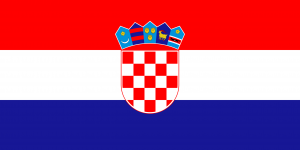Language/Croatian/Culture/Daily-Life-and-Customs
Introduction: Welcome to the lesson on Croatian daily life and customs! In this lesson, we will explore the social norms, etiquette, and family life in Croatia. Understanding the daily life and customs of a culture is essential for effective communication and building relationships with native speakers. By the end of this lesson, you will have a deeper understanding of Croatian society and be better equipped to navigate social situations and interact with Croatians. Let's get started!
Social Norms and Etiquette[edit | edit source]
Croatian society places great importance on politeness, respect, and hospitality. When interacting with Croatians, it is customary to greet others with a warm smile, a firm handshake, and direct eye contact. It is also common to use titles and surnames when addressing someone, especially in formal settings. For example, instead of saying "Dobar dan" (Good day), you can say "Dobar dan, gospodine/ gospođo" (Good day, sir/ madam).
When dining at someone's home or a restaurant, it is considered polite to wait for the host to start eating before you begin. It is also customary to keep your hands visible on the table and to avoid putting your elbows on the table. Saying "Dobar tek" (Enjoy your meal) before starting to eat is a common practice in Croatia.
Croatians value punctuality, so it is important to arrive on time for social events and appointments. If you are running late, it is polite to inform the person you are meeting. Additionally, it is customary to bring a small gift, such as flowers or chocolates, when visiting someone's home.
Family Life[edit | edit source]
Family plays a central role in Croatian society, and strong family ties are highly valued. Croatians often live in extended family households, with several generations living under one roof. Grandparents are respected and play an active role in the upbringing of children.
Family gatherings and celebrations are an important part of Croatian culture. Birthdays, weddings, and religious holidays are often celebrated with large meals, music, and dancing. It is common for family members to gather together on Sundays for a traditional lunch, which usually consists of roasted meat, potatoes, and vegetables.
Daily Routines and Leisure Activities[edit | edit source]
Croatians generally have a balanced approach to work and leisure. The typical workday starts at around 8 am and ends at 4 pm, with a lunch break in the afternoon. After work, Croatians enjoy spending time with their families, participating in sports activities, or simply relaxing.
Sports and outdoor activities are an integral part of Croatian daily life. Football (soccer) is the most popular sport in Croatia, and many Croatians are avid supporters of their local teams. Other popular sports include basketball, handball, and water sports such as swimming and sailing. The beautiful Adriatic coastline offers numerous opportunities for water activities and relaxation.
Cultural Section[edit | edit source]
Croatia's rich history and geographic location have influenced its culture and customs. There are also regional variations in daily life and customs within Croatia. For example, in coastal regions, seafood dishes are more prevalent, while inland regions are known for their hearty meat-based cuisine.
One interesting cultural fact is the tradition of "kumstvo" or godparenthood in Croatia. The relationship between the godparent and the child is considered very important and is often maintained throughout the child's life. The godparent is seen as a mentor and a role model, and they play a significant role in the child's upbringing.
Another unique aspect of Croatian culture is the tradition of "kolo" or circle dance. This traditional dance is performed at weddings and other celebrations, with participants holding hands and forming a circle. The kolo dance symbolizes unity and togetherness and is a joyful expression of Croatian identity.
Exercises[edit | edit source]
Now, let's practice what we've learned! Complete the following exercises to reinforce your understanding of Croatian daily life and customs.
Exercise 1: Vocabulary Matching Match the Croatian words with their English translations.
| Croatian | Pronunciation | English |
|---|---|---|
| obitelj | oh-bee-te-ly | family |
| gostoljubivost | goh-sto-lyoo-bee-vost | hospitality |
| pozdrav | poz-drahv | greeting |
| ručak | roo-chak | lunch |
| ples | pless | dance |
Exercise 2: Etiquette Scenarios Read the following scenarios and choose the most appropriate response based on Croatian etiquette. 1. You are invited to a friend's house for dinner. What should you bring? a) A bottle of wine b) A bouquet of flowers c) A box of chocolates
2. You are meeting someone for the first time. How should you address them? a) By their first name b) By their surname c) By their title and surname
Exercise 3: Cultural Research Choose one aspect of Croatian daily life or customs that interests you and conduct further research. Write a short paragraph summarizing what you have learned and share it with the class.
Solutions[edit | edit source]
Exercise 1: Vocabulary Matching - obitelj: family - gostoljubivost: hospitality - pozdrav: greeting - ručak: lunch - ples: dance
Exercise 2: Etiquette Scenarios 1. b) A bouquet of flowers 2. c) By their title and surname
Exercise 3: Cultural Research Results may vary. Here is an example: I chose to research traditional Croatian cuisine. I learned that Croatian cuisine is diverse and influenced by various regions and neighboring countries. Coastal regions are known for their seafood dishes, such as grilled fish and octopus salad, while inland regions offer hearty meat-based dishes like roasted lamb and "kulen" (a type of spicy sausage). Traditional Croatian desserts include "kremsnita" (Croatian custard slice) and "fritule" (small fried doughnuts). Croatian cuisine reflects the country's history and geography, and it is a significant part of Croatian culture and identity.
Sources[edit | edit source]
Other Lessons[edit | edit source]
- Travel and Tourism
- Traditions and Festivals
- Croatian Society and Politics
- Sports and Recreation in Croatia
- Religion and Spirituality in Croatia
- Arts and Entertainment
- Croatian Folklore and Mythology
- Education and Intellectual Life
- Society and Lifestyle in Modern Croatia

